|

This Parris-Dunn "Little Bobby" Helicopter Kite kit may well be the only one
left in existence. Many thanks to
Mr. Steven Krick
for providing the kit to me for documenting. A fairly extensive search on the World
Wide Web (WWW) turned up exactly zero other examples of this kit, or any mention
of it for that matter.
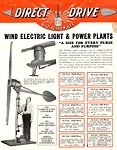 Parris-Dunn was primarily a wind-powered
electricity generator company located in Clarinda, Iowa, formed in the 1930s. In
the days before commercial electric power was delivered to rural areas, farms and
homes were run on DC (direct current) power provided by banks of lead-acid storage
batteries, so the generators were very popular as a means of recharging them. Many
early radio sets (known as "farm
radios") and household appliances - as well as electric lights - were designed
to run on DC, and also on either DC or AC. It filled the gap until after 1936 when
the Rural Electrification
Act was signed into law requiring utilities to make AC power available to everyone
(with government, aka tax dollars, subsidization if needed). As a side note, if
Thomas Edison had prevailed over Nikola Tesla in "The War
of the Currents," the AC versions would not have been needed. Parris-Dunn was primarily a wind-powered
electricity generator company located in Clarinda, Iowa, formed in the 1930s. In
the days before commercial electric power was delivered to rural areas, farms and
homes were run on DC (direct current) power provided by banks of lead-acid storage
batteries, so the generators were very popular as a means of recharging them. Many
early radio sets (known as "farm
radios") and household appliances - as well as electric lights - were designed
to run on DC, and also on either DC or AC. It filled the gap until after 1936 when
the Rural Electrification
Act was signed into law requiring utilities to make AC power available to everyone
(with government, aka tax dollars, subsidization if needed). As a side note, if
Thomas Edison had prevailed over Nikola Tesla in "The War
of the Currents," the AC versions would not have been needed.
 Prior to the joint venture with Cecil Parris,
William Dunn designed and built a full-size monoplane in 1928 called the
Dunn K-5
Cruzaire. That pretty much establishes his interest in things aeronautical,
including big propellers like those on his wind turbines and this helicopter-kite
model. Evidently two versions of the helicopter kite were produced: this Kit No. 1
Single Rotor "Little Bobby" (17" from wingtips to rudder) and a Kit No. 2 Twin
Rotor (45" from wingtips to rudder). My first thought about the moniker of "Little
Bobby" was that it was named after a son of either Parris or Dunn, but the drawing
on the box cover shows a girl flying the model. Lots of girls are nicknamed "Bobby,"
so it could very well be that Bobby was in fact a girl. Prior to the joint venture with Cecil Parris,
William Dunn designed and built a full-size monoplane in 1928 called the
Dunn K-5
Cruzaire. That pretty much establishes his interest in things aeronautical,
including big propellers like those on his wind turbines and this helicopter-kite
model. Evidently two versions of the helicopter kite were produced: this Kit No. 1
Single Rotor "Little Bobby" (17" from wingtips to rudder) and a Kit No. 2 Twin
Rotor (45" from wingtips to rudder). My first thought about the moniker of "Little
Bobby" was that it was named after a son of either Parris or Dunn, but the drawing
on the box cover shows a girl flying the model. Lots of girls are nicknamed "Bobby,"
so it could very well be that Bobby was in fact a girl.
The kit includes all material necessary to build the helicopter-kite, but my
kit is missing the sheet balsa parts and there is no metal hardware other than the
shaft, which has been bent into a curve shape. I did not attempt an inventory and
there is no parts list on the plans. Assembling the kit for successful flight would
be a real challenge for a novice modeler. In the flying instructions printed on
the plans, the draftsman warns the flyer to keep away from buildings and trees,
but there is no mention of avoiding overhead power lines. That was not a source
of potential hazard for the farm families who bought Parris-Dunn wind-powered electricity
generators!
Parris-Dunn is probably most well known for their production of training rifles
for the military during World War II. Many are still available on
eBay for interested collectors.
Three vintage kits generously
gifted to me by Steven Krick were offered to the Academy of Model Aeronautics' (AMA's)
National
Model Aviation Museum in Muncie, Indiana. I am happy to report that they now
have ownership of the
Parris-Dunn Helicopter Kite and the
Guillows
No. D4 Menasco Trainer. They were not interested in the
Comet F−86D Sabre Jet.
|

Parris-Dunn "Little Bobby" Helicopter Kite Kit Parts Overview

Parris-Dunn "Little Bobby" Helicopter Kite Box (top)

Parris-Dunn "Little Bobby" Helicopter Kite Box (top edge)

Parris-Dunn "Little Bobby" Helicopter Kite Box (bottom edge)
|
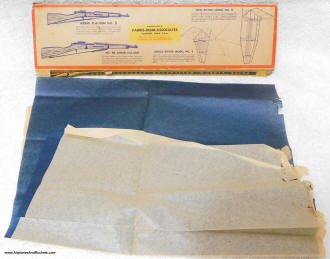
Parris-Dunn "Little Bobby" Helicopter Kite Tissue
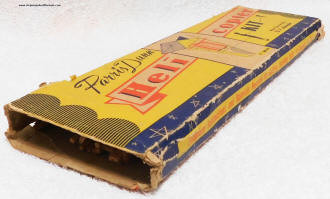
Parris-Dunn "Little Bobby" Helicopter Kite Box (end)

Parris-Dunn "Little Bobby" Helicopter Kite Box (bottom)
|
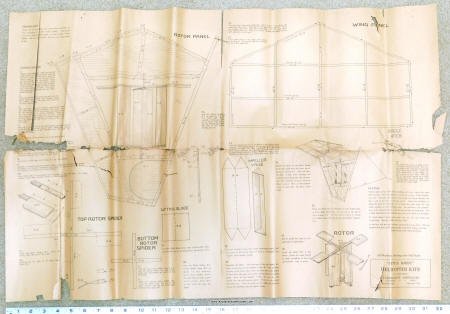
Parris-Dunn "Little Bobby" Helicopter Kite Plans
|

Parris-Dunn "Little Bobby" Helicopter Kite Plans (top left)
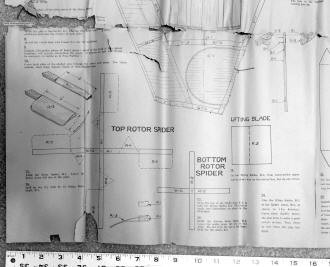
Parris-Dunn "Little Bobby" Helicopter Kite Plans (bottom left)
|
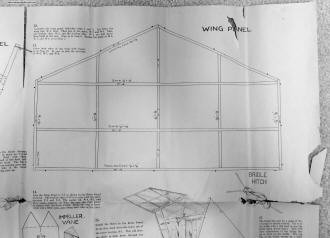
Parris-Dunn "Little Bobby" Helicopter Kite Plans (top right)

Parris-Dunn "Little Bobby" Helicopter Kite Plans (bottom right)
|
Posted July 6, 2019
|